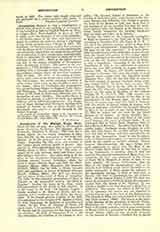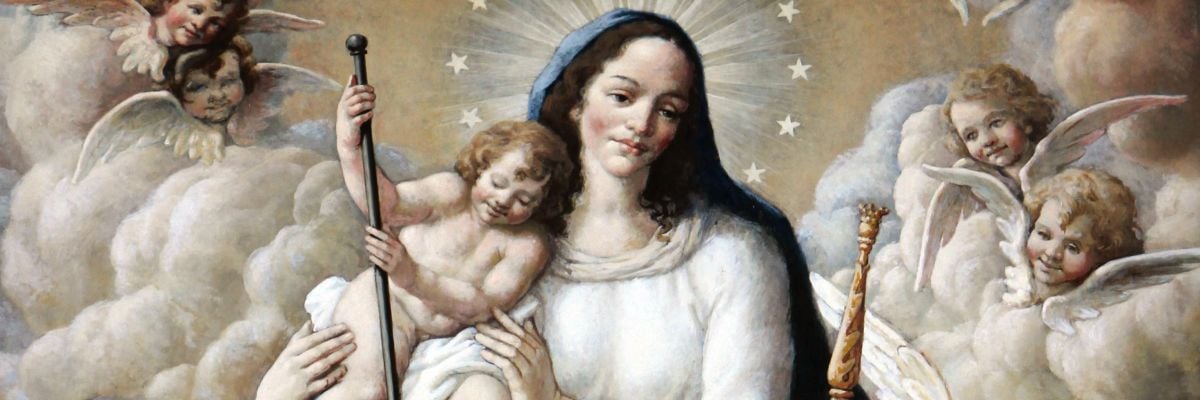

Assumption of the Blessed Virgin Mary, FEAST OF THE, August 15; also called in old liturgical books PAUSATIO, NATIVITAS (for heaven), MORS, DEPOSITIO, DORMITIO S. MARIAE. This feast has a double object: (I) the happy departure of Mary from this life; (2) the assumption of her body into heaven. It is the principal feast of the Blessed Virgin. Regarding the day, year, and manner of Our Lady’s death, nothing certain is known. Epiphanius (d. 403) acknowledged that he knew nothing definite about it (Ha?r., lxxix, 11). The dates assigned for it vary between three and fifteen years after Christ’s Ascension. Two cities claim to be the place of her departure: Jerusalem and Ephesus; common consent favors Jerusalem, where her tomb is shown [Nirschl, Hans and Grab der allerh. Jungfrau (Mainz, 1900); Mommert, Die Dormitio (Leipzig, 1900)]; but in 1906, J. Niesen brought forth new arguments in favor of Ephesus (Panagia Kapuli, Dulmen, 1906). The first six centuries did not know of the tomb of Mary at Jerusalem. The belief in the corporeal assumption of Mary is founded on the apocryphal treatise “De Obitu S. Dominae”, bearing the name of St. John, which belongs however to the fourth or fifth century. It is also found in the book “De Transitu Virgins”, falsely ascribed to St. Melito of Sardis, and in a spurious letter attributed to St. Denis the Areopagite. If we consult genuine writings in the East, it is mentioned in the sermons of St. Andrew of Crete, St. John Damascene, St. Modestus of Jerusalem and others. In the West, St. Gregory of Tours (De gloria mart., I, iv) mentions it first. The sermons of St. Jerome and St. Augustine for this feast, however, are spurious. St. John of Damascus (P.G., I, 96) thus formulates the tradition of the Church of Jerusalem: “St. Juvenal, Bishop of Jerusalem, at the Council of Chalcedon (451), made known to the Emperor Marcian and Pulcheria, who wished to possess the body of the Mother of God, that Mary died in the presence of all the Apostles, but that her tomb, when opened, upon the request of St. Thomas, was found empty; wherefrom the Apostles concluded that the body was taken up to heaven.”
Today, the belief in the corporeal assumption of Mary is universal in the East and in the West; according to Benedict XIV (De Festis B. V. M., I, viii, 18) it is a probable opinion, which to deny were impious and blasphemous. Regarding the origin of the feast we are also uncertain. It is more probably the anniversary of the dedication of some church than the actual anniversary of Our Lady’s death. That it originated at the time of the Council of Ephesus, or that St. Damasus introduced it in Rome, is only a hypothesis. According to the life of St. Theodosius (d. 529) it was celebrated in Palestine before the year 500, probably in August (Baeumer, Brevier, 185). In Egypt and Arabia, however, it was kept in January, and since the monks of Gaul adopted many usages from the Egyptian monks (Binumer, Brev., 163), we find this feast in Gaul in the sixth century, in January [mediante mense undecimo (Greg. Turon., De gloria mart., I, ix)]. The Gallican Liturgy has it on the 18th of January, under the title: Depositio, Assumptio, or Festivitas S. Marice (cf. the notes of Mabillon on the Gallican Liturgy, P.L., LXXII, 180). This custom was kept up in the Gallican Church to the time of the introduction of the Roman Rite. In the Greek Church, it seems, some kept this feast in January, with the monks of Egypt; others in August, with those of Palestine; wherefore the Emperor Maurice (d. 602), if the account of the “Liber Pontificalis” (II, 508) be correct, set the feast for the Greek Empire on August 15. In Rome (Batiffol, Brev. Rom., 134) the oldest and only feast of Our Lady was January 1, the octave of Christ’s birth. It was celebrated first at Santa Maria Maggiore, later at Santa Maria ad Martyres. The other feasts are of Byzantine origin. Duchesne thinks (Origines du culte chr., 262) that before the seventh century no other feast was kept at Rome, and that consequently the feast of the Assumption, found in the Sacramentaries of Gelasius and Gregory, is a spurious addition made in the eighth or seventh century. Probst, however (Sacramentarien, 264 sqq), brings forth good arguments to prove that the Mass of the Blessed Virgin Mary, found on the 15th of August in the Gelasianum, is genuine, since it does not mention the corporeal assumption of Mary; that, consequently, the feast was celebrated in the church of Santa Maria Maggiore at Rome at least in the sixth century. He proves, furthermore, that the Mass of the Gregorian Sacramentary, such as we have it, is of Gallican origin (since the belief in the bodily assumption of Mary, under the influence of the apocryphal writings, is older in Gaul than in Rome), and that it supplanted the old Gelasian Mass. At the time of Sergius I (700) this feast was one of the principal festivities in Rome; the procession started from the church of St. Hadrian. It was always a double of the first class and a Holy Day of obligation. The octave was added in 847 by Leo IV; in Germany this octave was not observed in several dioceses up to the time of the Reformation. The Church of Milan has not accepted it up to this day (Ordo Ambros., 1906). The octave is privileged in the dioceses of the provinces of Sienna, Fermo, Michoacan, etc. The Greek Church continues this feast to August 23, inclusive, and in some monasteries of Mount Athos it is protracted to August 29 (Menlea Grwca, Venice, 1880), or was, at least, formerly. In the dioceses of Bavaria a thirtieth day (a species of month’s mind) of the Assumption was celebrated during the Middle Ages, September 13, with the Office of the Assumption (double); today, only the Diocese of Augsburg has retained this old custom. Some of the Bavarian dioceses and those of Brandenburg, Mainz, Frankfort, etc., on September 23 kept the feast of the “Second Assumption“, or the “Fortieth Day of the Assumption” (double) believing, according to the revelations of St. Elizabeth of Schonau (d. 1165) and of St. Bertrand, O.C. (d. 1170), that the B. V. Mary was taken up to heaven on the fortieth day after her death (Grotefend, Calendaria 2, 136). The Birgittines kept the feast of the “Glorification of Mary” (double) August 30, since St. Birgitta of Sweden says (Revel., VI, lxii) that Mary was taken into heaven fifteen days after her departure (Colvenerius, Cal. March, August 30). In Central America a special feast of the Coronation of Mary in heaven (double major) is celebrated August 18 The city of Gerace in Calabria keeps three successive days with the rite of a double first class, commemorating: 15th of August, the death of Mary; 16th of August, her Assumption, and 17th of August, her Coronation. At Piazza, in Sicily, there is a commemoration of the Assumption of Mary (double second class) the 20th of February, the anniversary of the earthquake in 1743. A similar feast (double major with octave) is kept at Martano, Diocese of Otranto, in Apulia, 19th of November.


